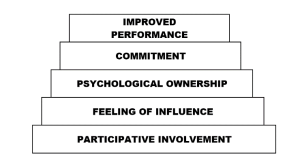 Most leaders want continuous improvement to take place in their organization. But do you ever stop and question your own leadership style and whether it promotes or hinders people from making improvements? Last week I attended the Salon sur les Meilleures Pratiques d’Affaires
Most leaders want continuous improvement to take place in their organization. But do you ever stop and question your own leadership style and whether it promotes or hinders people from making improvements? Last week I attended the Salon sur les Meilleures Pratiques d’Affaires  (Best Business Practices) organized by le Movement Québecois de la Qualité. The well attended trade show and conference was full of companies showcasing examples of their continuous improvement successes as well as vendors of all types of quality programs, consulting services and training courses. What was very clear from those promoting best practices was the importance of leaders adapting a participative leadership style. All the best practices for assuring quality standards and high performance are based on employee participation. This translates into empowered, autonomous employees and teams.
(Best Business Practices) organized by le Movement Québecois de la Qualité. The well attended trade show and conference was full of companies showcasing examples of their continuous improvement successes as well as vendors of all types of quality programs, consulting services and training courses. What was very clear from those promoting best practices was the importance of leaders adapting a participative leadership style. All the best practices for assuring quality standards and high performance are based on employee participation. This translates into empowered, autonomous employees and teams.  So what is a participative leadership style and how to develop it? It means involving people in decision making and coming to consensus on decisions that employees are responsible for implementing. It means establishing expectations for performance and productivity and empowering teams to work together and solve problems on their own to continuously improve their work. It means listening and giving feedback but not telling. It means coaching people rather than ordering or ignoring. Participative leadership is just one style. On one end is autocratic leadership and the opposite end is democratic. There are times you must be autocratic in your style. For example the fire chief practices participative leadership when there is no fire. But when there is a fire he becomes the director and shouts orders. However, everyone accepts this because they understand the situation and trust the leader. They know this style is required under the circumstance. The same is true in business. Sometimes you need to practice participate leadership and at other times autocratic. But to promote teamwork and continuous improvement you need to adapt a participative style most of the time. This requires a shift in thinking and behaviour. The fundamental behaviors for the leader to put into practice to be a participative leader are:
So what is a participative leadership style and how to develop it? It means involving people in decision making and coming to consensus on decisions that employees are responsible for implementing. It means establishing expectations for performance and productivity and empowering teams to work together and solve problems on their own to continuously improve their work. It means listening and giving feedback but not telling. It means coaching people rather than ordering or ignoring. Participative leadership is just one style. On one end is autocratic leadership and the opposite end is democratic. There are times you must be autocratic in your style. For example the fire chief practices participative leadership when there is no fire. But when there is a fire he becomes the director and shouts orders. However, everyone accepts this because they understand the situation and trust the leader. They know this style is required under the circumstance. The same is true in business. Sometimes you need to practice participate leadership and at other times autocratic. But to promote teamwork and continuous improvement you need to adapt a participative style most of the time. This requires a shift in thinking and behaviour. The fundamental behaviors for the leader to put into practice to be a participative leader are:
- Maintain and grow the self-esteem of employees
- Listen and respond with empathy
- Ask for help to solve problems
- Provide support without removing responsibility
 There fundamentals are well explained in the narrative book Zapp! The Lightning of Empowerment. In fact we use this book as part of our Style of Leadership and Team Development training program for leaders. Leaders must strike a balance between being and doing. In other words before doing the practices associated with quality programs and continuous improvement initiatives, they must start putting into practice the behaviors that foster trust, openness and engagement. The key is to start step by step. Develop an understanding by reading Zapp or get some training in interpersonal behavior skills aimed at coaching people and developing a participative leadership style. Hold problem solving meetings at the management level to eliminate problems that cause you to be fighting fires too often. If you can shift more time to plan, set goals, coach people etc. you will start becoming a participative leader.
There fundamentals are well explained in the narrative book Zapp! The Lightning of Empowerment. In fact we use this book as part of our Style of Leadership and Team Development training program for leaders. Leaders must strike a balance between being and doing. In other words before doing the practices associated with quality programs and continuous improvement initiatives, they must start putting into practice the behaviors that foster trust, openness and engagement. The key is to start step by step. Develop an understanding by reading Zapp or get some training in interpersonal behavior skills aimed at coaching people and developing a participative leadership style. Hold problem solving meetings at the management level to eliminate problems that cause you to be fighting fires too often. If you can shift more time to plan, set goals, coach people etc. you will start becoming a participative leader.  Our leadership styles and team development training program provides a foundation for developing the core competencies of becoming a participative leader and stimulating teamwork.
Our leadership styles and team development training program provides a foundation for developing the core competencies of becoming a participative leader and stimulating teamwork.